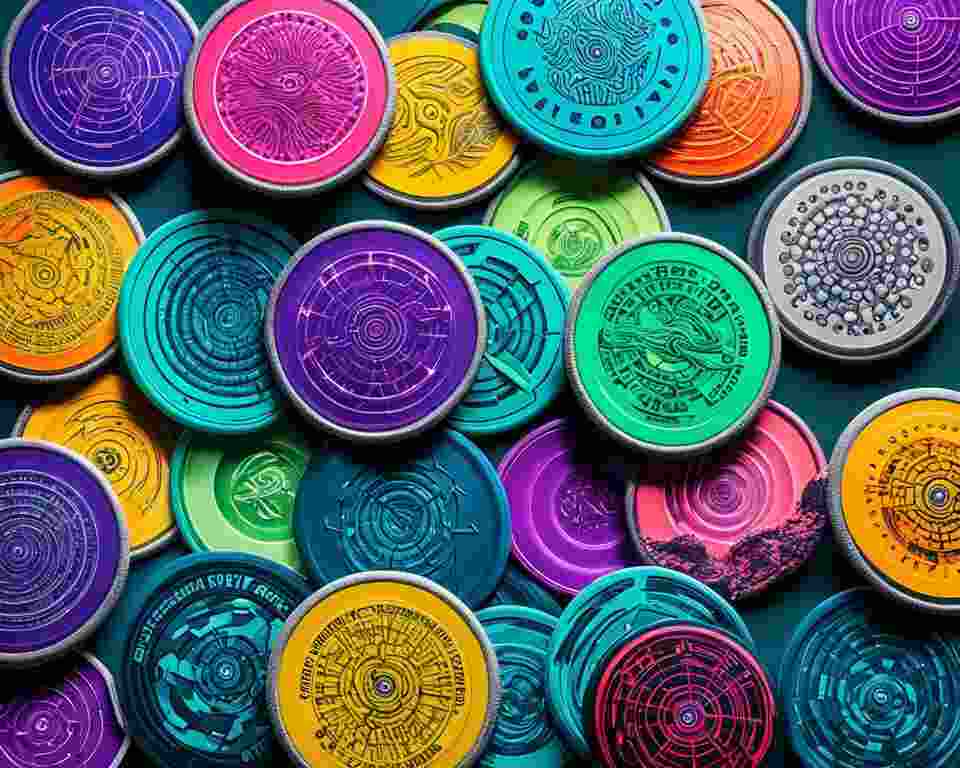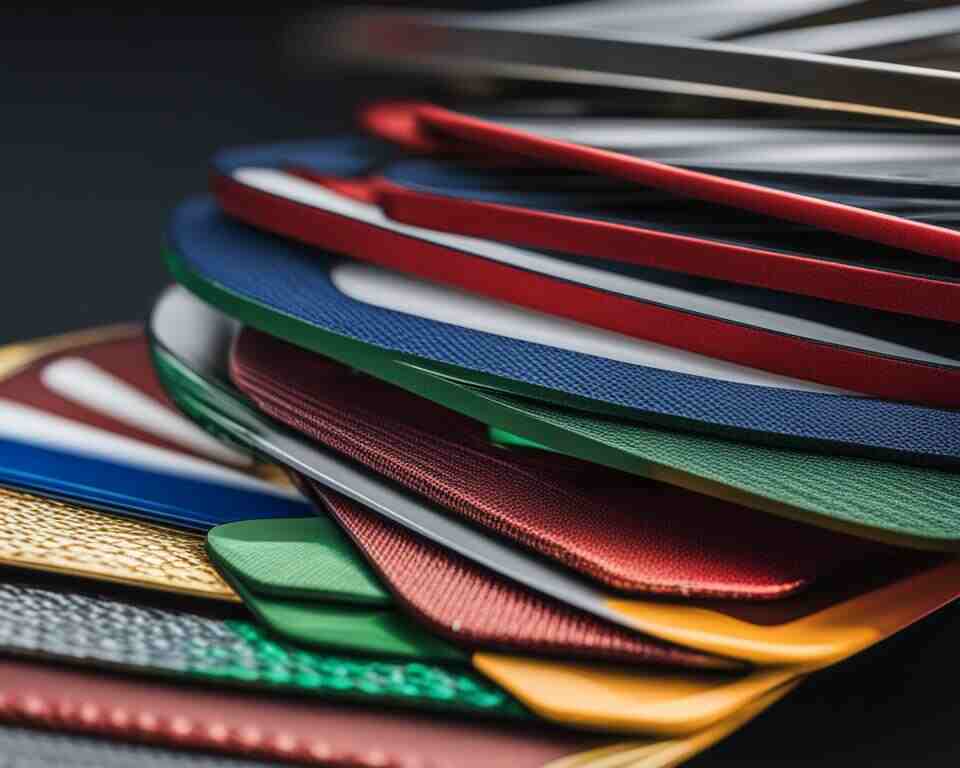Welcome to my guide on disc golf disc materials! As a passionate disc golfer, I understand the importance of choosing the right disc for every throw. The materials used in disc construction play a significant role in the performance and durability of the discs.
In this article, I will explore the composition and types of disc golf disc materials, providing valuable insights to help you make informed decisions when selecting discs.
Key Takeaways:
- Understanding disc golf disc materials is crucial for choosing the right disc for your game.
- Different materials have unique properties that affect disc flight characteristics and durability.
- Common disc golf disc materials include polypropylene, polyethylene, TPE, and polyurethane plastics.
- The composition and manufacturing process of disc golf discs have evolved over time to enhance performance.
- Consider your personal preferences and practical applications when selecting disc materials.

What are Disc Golf Discs Made of
In the world of disc golf, the composition of disc golf discs plays a crucial role in their performance and durability. Understanding what these discs are made of can help players make informed decisions when selecting the right discs for their game. Let’s explore the common materials used in the manufacturing of disc golf discs and how they contribute to their performance on the course.
Disc golf discs are typically made using various types of plastic materials. These plastics are chosen for their specific properties that affect factors such as flight characteristics, flexibility, and durability. Some of the popular plastic types used in disc golf disc production include:
- Polypropylene
- Polyethylene
- Thermoplastic elastomer (TPE)
- Polyurethane plastics
Each of these plastic types offers unique characteristics that impact the way a disc flies and performs. For example, polypropylene discs tend to be stiff and resilient, providing consistent flights even in windy conditions. On the other hand, polyethylene discs offer more flexibility and grip, making them suitable for players with less throwing power. The choice of plastic material depends on the player’s skill level, throwing style, and desired flight characteristics.

By exploring the materials used in disc golf disc construction, players can gain a better understanding of how these materials influence the disc’s flight path, stability, and overall performance. It’s important to consider factors such as plastic type, disc weight, and disc design when selecting the right disc for different types of throws and course conditions.
In the next section, we will dive deeper into the manufacturing processes behind disc golf discs and explore the evolution of disc materials over time.
Understanding Disc Golf Disc Materials and Their Manufacturing
Disc golf discs are meticulously designed and manufactured using various materials to enhance their performance and durability.
Let’s look deeper into the fascinating world of disc golf disc materials and manufacturing.
The Evolution and Composition of Disc Golf Discs
Disc golf discs have come a long way since their inception. Initially made of wood and other non-durable materials, modern disc golf discs are primarily constructed using thermoplastic resins. These resins offer a unique combination of strength, flexibility, and durability, allowing discs to withstand the rigors of the game.
The composition of disc golf discs can vary depending on the desired flight characteristics and player preferences. Manufacturers carefully select and blend different plastics to achieve specific disc properties such as stiffness, grip, and glide. By experimenting with different plastic formulations, manufacturers constantly push the boundaries of disc performance.
Thermoplastic Resins: The Backbone of Disc Golf Disc Construction
Thermoplastic resins, such as polypropylene and polyethylene, form the backbone of disc golf disc construction. These materials are known for their excellent impact resistance and ability to retain their shape even after repeated throws. Additionally, they offer a high degree of flexibility, ensuring the discs can withstand the forces exerted during flight and landings.
The use of thermoplastic resins allows for the creation of discs with varying flight characteristics. Discs made from different blends of these resins can exhibit different levels of stability, glide, and fade. This versatility enables players to choose discs that suit their throwing style, skill level, and environmental conditions.
Injection Molding: The Process Behind Disc Manufacturing
Injection molding is the primary manufacturing process used to produce disc golf discs. This process involves injecting molten plastic into a mold cavity, allowing it to cool and solidify into the desired disc shape. Injection molding ensures consistent quality, precision, and repeatability in disc production.
During the injection molding process, manufacturers can incorporate additional features, such as weight variations, textured surfaces, and intricate flight patterns, to further enhance disc performance. The ability to customize discs through injection molding has revolutionized the sport, providing players with an extensive range of options to suit their individual needs.
Environmental Considerations in Material Selection
As the sport of disc golf continues to grow, so does the need for environmentally sustainable practices. Manufacturers are increasingly considering the environmental impact of disc materials and the production process. Some companies are exploring the use of recycled plastics or biodegradable materials to reduce their carbon footprint.
By making conscious choices in material selection, manufacturers can contribute to the preservation of natural resources and the reduction of waste. Players can also support these initiatives by choosing discs made from eco-friendly materials, promoting a more sustainable future for the sport of disc golf.
Understanding the materials and manufacturing processes behind disc golf discs provides valuable insights into the performance and durability of these essential tools. As the sport evolves, so does the innovation in disc materials, leading to continued advancements in disc technology and exciting possibilities for future disc designs.

Conclusion
Throughout this article, I have explored the composition, types, and manufacturing processes of disc golf discs, highlighting the significance of disc material in their performance and durability. The choice of disc material plays a crucial role in determining flight characteristics and overall playability.
The Significance of Disc Material in Performance and Durability
The material used in disc golf discs greatly influences their performance on the course. Different materials have varying levels of grip and flexibility, which impact the disc’s ability to maintain consistent flight paths. Discs made from high-quality plastics offer better durability, ensuring that they can withstand the rigors of intense gameplay without compromising their flight performance.
Additionally, the weight and stability of a disc are also influenced by its material composition. Certain plastics have a higher density, resulting in discs that are more stable and resistant to turning during flight. On the other hand, discs made from lighter materials can offer increased glide and distance, making them suitable for players with slower arm speeds.
Exploring Varieties: Personal Preferences and Practical Applications
When selecting a disc, personal preferences and the intended use play an important role. Different materials offer distinct advantages based on an individual’s throwing style, skill level, and course conditions. For instance, beginners may benefit from discs made of softer, more forgiving plastics, while advanced players may prefer stiffer, more durable materials for maximum control and consistency.
Practical applications also come into play when choosing disc materials. Discs designed for specific shots, such as drivers, mid-ranges, and putters, often utilize different materials to optimize their performance. Manufacturers continuously innovate their disc designs and materials to cater to the evolving needs and preferences of players, ensuring a diverse range of options on the market.
Future of Disc Golf Technology and Material Innovation
As the sport of disc golf continues to grow in popularity, we can expect further advancements in disc technology and material innovation. Manufacturers are constantly researching and developing new materials to enhance disc performance and durability. Future disc materials may offer superior grip, increased durability, and enhanced flight characteristics, allowing players to achieve even greater distances and accuracy on the course.
In conclusion, the choice of disc material in disc golf discs is of paramount importance. Understanding the properties and characteristics of different materials allows players to make informed decisions when selecting discs that suit their unique preferences and gameplay style. By staying up-to-date with the latest innovations in disc technology, players can enhance their performance and elevate their enjoyment of the game.

